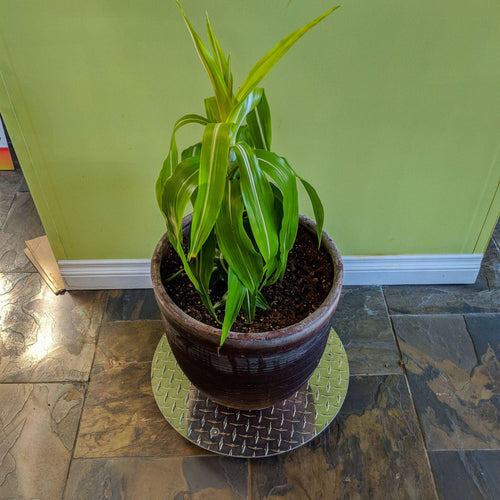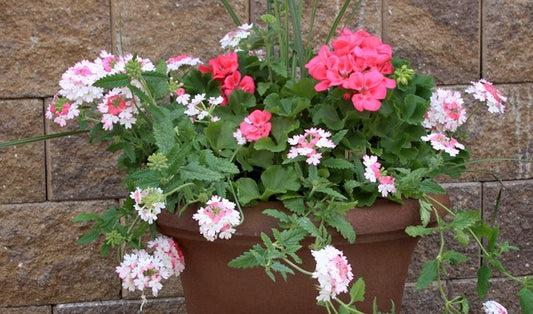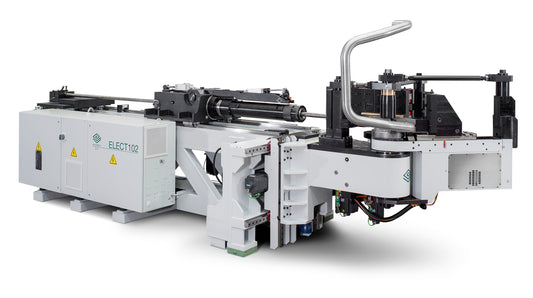Short day lengths and cold outdoor temperatures hinder the ability for many people to garden throughout the winter months. This doesn’t mean gardening has to halt completely though. There are many ways to keep your hands in the soil by creatively bring gardening indoors during the winter.
1. Move Tender Perennials Inside to Care for Them.
Depending on the climate in your area and the types of perennial plants you’ve chosen to put in your yard or garden, it may be necessary to move some indoors during the harsh winter months. Bringing them inside protects them from the winter elements keeping them strong and healthy. In turn, strong healthy plants are better able to fend off insects, diseases and any other stressors they encounter when moved back outside.
To make the moving process easier, invest in a high-quality heavy-duty rolling plant caddy to save strain on your back. Plants are quickly and easily rolled from your patio or deck into the living room, dining room, or den to accent your home’s interior decor.
2. Start a Windowsill Herb Garden.
Growing herbs indoors in containers is a great way to brighten your kitchen with greenery and garden all year long. Herbs are easy to grow, with many requiring very little care other than basic watering and periodic fertilization. Choose some of your favorites such as basil, rosemary, or cilantro, to give yourself access to fresh herbs any time a recipe calls for them.
Choose from a prefabricated herb garden kits, or personalize the herb garden to your own style by mixing and matching a variety of containers or building a unique display. Place your plants close to a south or west-facing window for optimum sun exposure but try to keep them out of cold drafts that cause plant stress.
3. Build a Terrarium.
Hugely popular in the 1970s, terrariums are making their way back into homes at a rapid pace. A terrarium is a glass vessel containing plants and growing medium creating a self-contained miniature ecosystem. These low maintenance gardens are a great way to bring nature indoors.
To build your own terrarium start by choosing a clear glass vessel with an opening wide enough to easily work with -- you want to get your hand into it without it getting stuck. Vessels can be open or enclosed. Open containers are better for succulents, cacti, etc; vessels with a lid work well for tropical plants liking high humidity levels. Then look for plants with similar sunlight and humidity needs, choosing plants that are slow growing or smaller in stature.
4. Start a Fairy Garden.
Like terrariums, the popularity of fairy gardens is rising quickly, especially among homeowners with young children. Fairy gardens provide a touch of whimsy to your home while teaching kids the basic tenants of indoor gardening.
Choose a fun container as the base: a brightly colored flower pot, a basket lined with plastic, or even an old washtub. Fill with potting soil and your favorite miniature plants, adding in fun details such as stone walkways, tiny houses, and other fun accessories for your fairies.
5. Regrow Foods From Kitchen Scraps.
Many people aren’t aware that numerous foods are easily regrown from the scraps that normally get tossed in the trash. Instead of throwing them away, save on your grocery budget and get your winter gardening fix on by regrowing them.
An added bonus is certain foods don’t need any supplies other than what you already have in your kitchen. Celery, green onions, lemongrass, and romaine lettuce don’t even require planting containers or potting soil! They can be regrown in nothing more than fresh water in a glass jar.
This is a cheap and easy way to do a little organic gardening during the doldrums of winter.
6. Grow Salad Greens.
Salad greens are incredibly simple to grow, with many varieties going from seed to harvest-able greens quickly. Choose from leaf lettuce, spinach, kale or swiss chard; all of these plants do well in the cooler temperatures in homes (relative to higher outdoor temps in July and/or August).
Fill wide, shallow containers with pre-moistened high-quality potting soil and sow seeds directly at the required spacing. Allow plants to get plenty of sunlight while keeping the potting soil moist but not damp. Within 4 - 6 weeks from the time of planting, greens are ready to harvest. Plant new seeds every couple of weeks for a continuous supply of fresh greens throughout the winter.
7. Start Seedlings for Your Spring Garden.
Often times, you buy a mix of seeds and seedlings/small plants for your spring gardening projects. Why not try your hand at starting plants like peppers and tomatoes from seed instead? Starting your own seeds saves money while simultaneously “gardening” indoors way ahead of the spring planting schedule.
To get started you’ll need planting trays or peat pots made for seed starting, high-quality potting mix, and the desired seeds. If your windows don’t receive enough sunlight, supplemental growing lights help keep plants from getting “leggy” from lack of light.
If you’re short on space in the kitchen for growing herbs, salad greens or seedlings, or you simply need more room for your terrarium or fairy garden, think about adding some additional shelving to hold your indoor gardening adventures. Choose sleek stainless steel floating shelves for a modern look or install shelf brackets to build custom shelving to match your home’s style and decor.
Unfavorable outdoor conditions through the winter doesn’t mean gardening has to halt completely. With a little creativity, it’s easy to enjoy indoor gardening activities when the weather prevents you from getting outside.






2 comments
Hello there, You have done a great job. I will certainly digg it
and personally suggest to my friends. I’m sure they’ll be benefited from this web site.
pastebin.fun
Good post. I learn something new and challenging on websites I stumbleupon everyday.
It will always be interesting to read content from other writers and practice a little something from their web sites.
vvfit.com